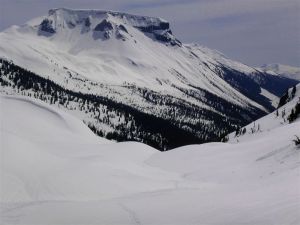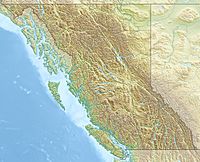Ring Mountain (British Columbia) facts for kids
Quick facts for kids Ring Mountain |
|
|---|---|
 |
|
| Highest point | |
| Elevation | 2,192 m (7,192 ft) |
| Prominence | 260 m (850 ft) |
| Geography | |
| Location | British Columbia, Canada |
| Parent range | Pacific Ranges |
| Geology | |
| Age of rock | Unknown |
| Mountain type | Tuya |
| Volcanic arc/belt | Canadian Cascade Arc Garibaldi Volcanic Belt |
| Last eruption | Unknown |
| Climbing | |
| First ascent | 1968 John Clarke |
Ring Mountain, also called Crucible Dome, is a special type of volcano called a tuya. It is found in British Columbia, Canada. This interesting mountain is part of the Mount Cayley volcanic field.
Ring Mountain has a unique horseshoe-shaped crater. This crater is on the east side of the upper Squamish River.
What is a Tuya?
A tuya is a volcano that erupts under a thick glacier or ice sheet. When the hot lava meets the cold ice, it cools very quickly. This fast cooling creates a flat-topped, steep-sided mountain.
Ring Mountain is a great example of a tuya. Its shape shows how it formed long ago when ice covered the land.
How Ring Mountain Formed
The exact age of Ring Mountain is not known. However, scientists believe it likely formed during the Fraser Glaciation. This was a time when large glaciers covered much of Canada.
Many tuyas in Canada were created during this icy period. The interaction between the lava and the massive glaciers shaped these unique mountains.
Ring Mountain's Features
The rocks on the western side of Ring Mountain are very interesting. They have many small cracks and breaks. These cracks make the rocks look like tiny spires and knobs.
This mountain is part of the Canadian Cascade Arc and the Garibaldi Volcanic Belt. These are areas where many volcanoes are found.
First Ascent
The first time someone officially climbed to the top of Ring Mountain was in 1968. The mountaineer who achieved this was John Clarke.
Climbing a tuya can be challenging because of its steep sides. It's a great achievement for any climber.


